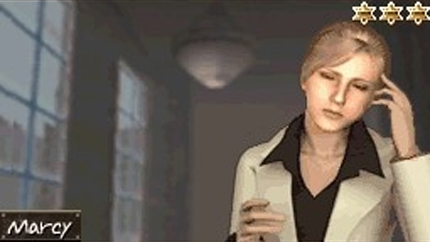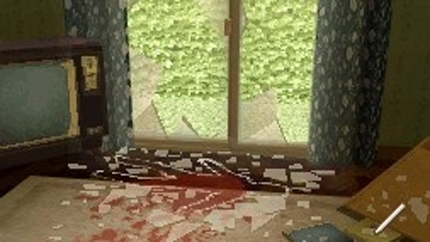Of all the real-world careers around which to build an adventure game, none seems more logical than that of a police detective. Rational, engaging puzzles are crucial to any enjoyable adventure, so the act of piecing together clues and solving crimes ought to be a perfect fit for the genre. Yet while many have tried, scant few games have managed to take the concept of detective work and turn it into something compelling. Unsolved Crimes for the DS is the latest such attempt, and while it's a competent effort, most gumshoes will wish that these criminal webs were a little more challenging to untangle.

It's 1976, and you're a rookie detective with the NYPD's homicide division. Unsolved Crimes models itself after cop shows of the era, establishing its style nicely with a cool title sequence that makes use of appropriately dated video footage of the Big Apple and some quintessentially '70s theme music. As the unnamed, unseen detective, you're partnered up with the young but experienced Marcy Blake, working cases with her and following orders from the gruff but likable Captain Abbot. The murders you investigate range from neat and tidy poisonings to truly grisly axe murders. Your investigations also take you to a good variety of crime scenes, including a small suburban home, a city park, and a fleabag motel.
Each case starts with a briefing in which Abbot fills you in on the known details of the murder. Then, he sends you and Marcy off to the crime scene to get to the bottom of things. You're given a few pieces of preliminary evidence, as well as a list of suspects and snippets of testimony concerning their alibis or important details they may have witnessed. As you examine the crime scene--viewing it from a first-person perspective and tapping on details that you want to examine--you'll discover things that let you slowly deduce the facts behind the murder. The cases themselves are quite engaging. Just slowly piecing things together to reveal the bigger picture--who did it, how, and why--is rewarding for anyone who enjoys a mystery. But the game doesn't make the most of the material with which it has to work. Although the cases get increasingly complex as you progress, the gameplay doesn't.
More often than not, you deduce the facts of the crime by answering simple multiple-choice questions. After coming across a particular detail at the crime scene or in your evidence collection, Marcy asks you to point out an inconsistency in someone's testimony, for instance, or identify the way evidence supports a certain theory of how the murder was committed. Then, you're presented with four possible answers. Being observant and attentive to the particulars of the case is helpful, but frequently, even if you haven't been paying much attention, it's easy to eliminate one or two of the choices because they're just plain goofy. If you guess incorrectly one too many times, you'll be unceremoniously kicked off the force, but this doesn't matter much. You can always pick up again from that point, so it's entirely possible to just fumble your way through much of an investigation. The game's take on detective work is a lot less engaging than it might have been because of the simplicity of this gameplay contrivance.
Far less common but a lot more interesting are those moments in each case when you're not given four options to choose from but must point to a specific piece of evidence, a detail of the crime scene, or a snippet of testimony that's vital to advancing the investigation. It's in these more challenging, intellectually stimulating moments that you feel more like a vital part of the investigation and less like a student taking a simple quiz. On occasion, you may feel that there are a few equally viable choices, and you'll wish you could just explain your thinking to Marcy as she calls you a schmuck for making the wrong choice. But most of the time, there's a pretty sensible logic to these moments that reward skills of observation and deduction. From time to time, you'll also get to do such things as determine the trajectory of a bullet or conduct a simple physics experiment that reveals a crucial detail of a crime scene. The one thing you never get to do, unfortunately, is interrogate suspects. You're constantly answering questions but never asking them yourself. When you consider that sweating details out of suspects is such a familiar part of so many cop shows and detective novels, never getting to interact with suspects face-to-face here is a bit disappointing.
Interspersed among the eight independent cases is an ongoing subplot about a kidnapping case that involves very little in the way of investigation. Instead, these intervals bring about very simple action sequences. At one point, you're involved in a car chase and must swerve left or right to avoid debris as you pursue the escaping criminal. Later, there's a warehouse shootout in which you must wait for thugs to pop out from behind cover and then tap them with the stylus to shoot. There's nothing to these sequences that makes them worthy of revisiting, but they do lend a bit of classic cop-movie action to the proceedings. And the game goes out strong, with a particularly suspenseful final case that ties up some loose ends and makes good use of the touch screen.
Unsolved Crimes is unremarkable visually. The 3D crime scene environments aren't very impressive to look at, but they do have enough little details and variety to make the act of exploring them fun throughout. The character portraits for Marcy, Abbot, and others only have a handful of expressions you'll see constantly repeat, but their realistic style fits well with the serious tone of the game. The use of music is sparing, but it does help ground the game in the 1970s. The environmental sound effects, such as the constant ringing of phones and clacking of typewriters at the police station, also creates a sense that the game's world extends beyond the small areas you get to investigate.

Unsolved Crimes' eight cases will probably take most players roughly an hour each, with the latter cases being more involved than the earlier ones. There's no replay value here because once you've solved the case, there's really nothing else to get out of the experience. The simplicity of the overused multiple-choice structure to the investigations will leave most armchair detectives wanting for something more involved, but even so, there's still enough murderous goodness here that mystery aficionados may want to get to the bottom of these Unsolved Crimes.



